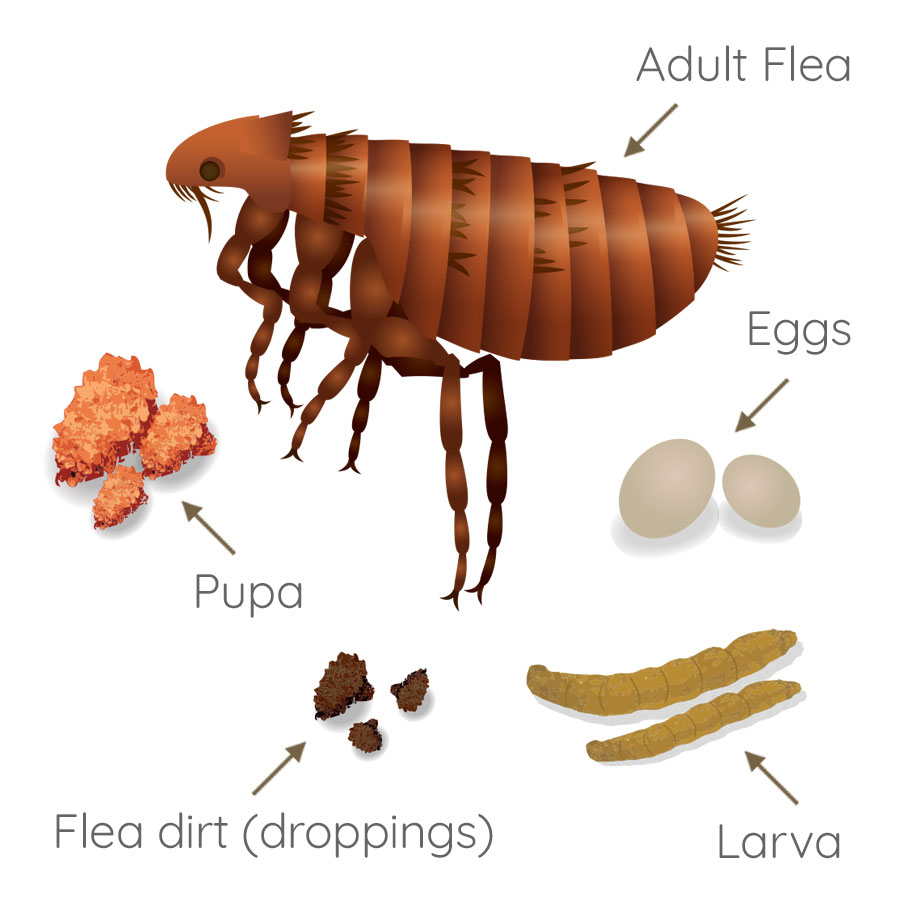The adult fleas we see on our pet only represent 5% of the whole population in the home environment.
OVERVIEW
The flea, or to be more specific, the cat flea can live on most mammals, including dogs, cats, possums, foxes, chickens, and even koalas. When a flea bites, its saliva causes the pet, or us, to itch. Fleas not only cause skin problems for our pets and us but can also cause other diseases such as anaemia, flea allergy dermatitis and tapeworms.
The adult fleas we see on our pet only represent 5% of the whole population. The rest of the flea population in the form of maggots and eggs live in the environment waiting for mammals to walk by. Pets can pick up fleas from the environment such as from within the grass, soil or carpet and generally from areas not in direct sunlight.

Flea problems can appear to come and go. This is because the immature stages of the flea (eggs, pupae) wait in the environment for the right conditions and when this happens they tend to hatch all at once onto the unsuspecting pet.

SIGNS
Common signs of flea allergy dermatitis in dogs:
- Scratching, licking, chewing
- Hair loss (usually at base of tail)
- Scabbing
- Reddened or thickened skin
Some pets develop a severe allergic reaction to the flea saliva and can develop flea allergy dermatitis. It appears to be more of a problem in dogs exposed intermittently to fleas rather than those that harbour large numbers of fleas.

MANAGEMENT
Managing fleas can be a frustrating and requires a long-term management plan. The key to successful management is persistence and consistency in treating the pet and the environment.
Tips to help manage and prevent a flea infestation:
- Treat all pets in the household with a good quality flea product
- Follow product instructions for application and usage i.e. monthly
- Make sure the pets are receiving the correct product for weight and pet
- Keep the environment clean such as between tile cracks and paving
- Reduce fleas by staying away from flea areas (under the house, under cool, shady trees)
- Vacuum regularly to remove immature flea stages from the environment
- Wash pet bedding, blankets in water greater than 60ºC for 10 minutes to kill any immature flea stages
- Place rugs, cushions, doormats in direct sunlight weekly to kill immature flea life stages
- Keep wildlife out of the yard
- Check your pet’s coat regularly for fleas and ticks, especially after a walk, and avoid these areas if large numbers of fleas are picked up
- Do not bathe your pet with detergent, cleaning agents, soap or human shampoo as these products can strip the natural oils from your pet’s coat and impair topical flea treatments
- For pets that swim daily or have been prescribed medicated shampoo, talk to your veterinarian about appropriate waterproof flea products or oral medications
- For oral flea medications, ensure the pet ingests all the medication and doesn't spit it up later on
FLEA PREVENTION FAILURE
On rare occasions, you may still see fleas even when your pet has been treated for fleas. Such failures can occur when:
- Using a product that is not good quality
- The flea product dose is incorrect for the pet species or size
- The flea product does not have an insect growth regulator (IGR) to prevent the fleas from reproducing
- The flea product is administered incorrectly or unsatisfactorily, for example, oral flea tablets are not completely ingested by the pet or a topical product is split amongst multiple pets
- Applying topical products onto a wet pet such as after swimming or a bath
- Not all pets in the household are treated. This commonly occurs in a dog and cat household where the cat is not treated for fleas as fleas are never seen on the cat (usually due to good grooming). Unfortunately, fleas can still irritate the cat and breed on the untreated cat.
If your pet is on a good quality product and the treatment has been applied according to the instructions, it is unlikely there is a product failure and more likely that the flea challenge is higher than normal and you are merely seeing the fleas that jump on your pet before they die. In these cases, it is important to try and identify the environmental infestation such as under the house, in the pet's bedding, and use adequate cleaning practices to remove them.















